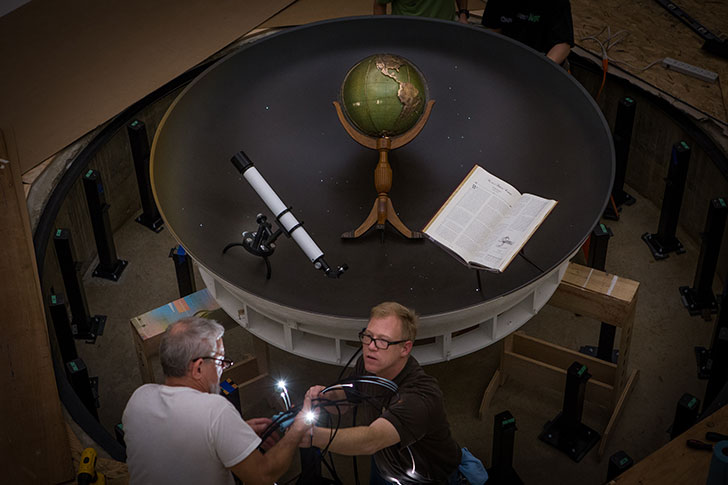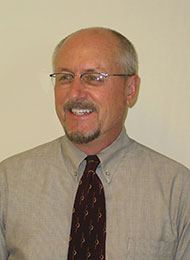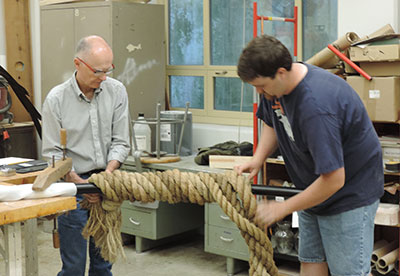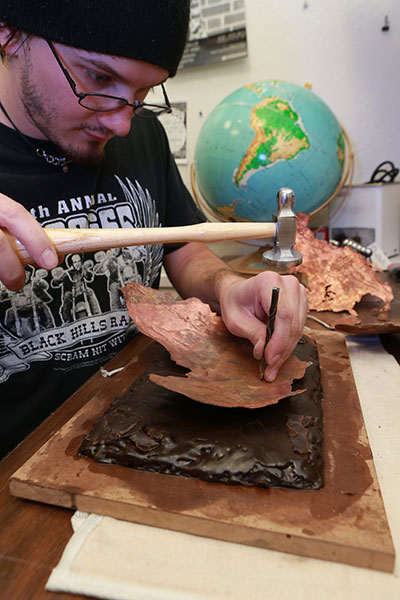

3-D version of university seal installed at new student center
Miami brings the seal to life

Robert Keller
![]() Discover the inspiration behind the seal's construction
Discover the inspiration behind the seal's construction
Explore an online interactive seal
When the new Armstrong Student Center opens in January, a focal point will be the Great Seal, a 3-D representation of the university seal, created with real objects and containing students' words and artwork to link the university's past, present and future.
Installation started Dec. 2 on the seal measuring nearly 12 feet across and set almost 3 feet into the floor. It will grace the center’s Bicentennial Rotunda beneath a dome that's visible from Spring Street.
Just like the seal embedded in the hub at the center of campus, this one will depict a globe, a telescope and an open book, along with the university motto, Prodesse Quam Conspici ("to accomplish without being conspicuous"), inside a roped circle.
Robert Keller (Miami '73), university architect emeritus who is now Miami's planning and design manager, came up with the idea nearly three years ago to make this seal three-dimensional.
Several students, along with faculty, staff, administrators and alumni, had a hand in the project, and each of the featured objects also is tied to Miami.
"One of the neatest things about the whole project is that so many people have been involved," Keller said. "Each piece has a story."
Graduate student Ben Mark cuts continents from sheet bronze for the globe.
A globe, a telescope and a book
A glass globe, lighted from inside, and its vintage wooden stand were discovered in the observatory of physics’ Culler Hall. The globe represents the present moment shared by all.
When Keller realized it was a celestial globe, a map of the stars, he tapped Ben Mark — a master's of fine arts student in metalsmithing — to turn it into the earth by creating continents that would float a quarter inch above the surface.
Mark used a jeweler's saw to cut the continents from sheet bronze and then heated the metal to create mountains and other texture.
"I got a lot of insight into working on a larger scale, which was interesting," said Mark of Danville, N.Y.
The telescope, also from the physics department, points to the future yet to be discovered. Staff members in the instrumentation laboratory in Hughes Hall made a base for it that was designed by an adjunct associate professor of physics.
The objects are life-size, including the book, created with paper produced on campus.
It will be open to a page featuring the Great Seal Writing Contest's grand prize-winning essay, “We, on a path to wisdom," by journalism and professional writing major Amanda Hancock.
Her essay, in which she strives to capture the collective experience on campus, was chosen from dozens of entries submitted to the contest last spring after President David Hodge invited students to mark the opening of the Armstrong Student Center by helping to "literally write the book" inside the seal.
In addition to other winning essays, the book will contain 12 pen-and-ink sketches of Miami landmarks rendered by sisters Madelyn and Sophia Delgado, now seniors in architecture and interior design from Lebanon.
Representing the past, the book is the accumulated wisdom of the centuries passed to the present generation through their reading.
Hancock said she's thrilled that her words will soon become part of Miami's story: “We burn the midnight oil … a few times. We sing the fight song at the top of our lungs. We discover, we search, we learn. We immerse ourselves in an ongoing pursuit of the best version of ourselves.”
“I feel so honored that my writing will be seen in such a unique way,” said Hancock, a junior from Lexington, Ky.
A rope and some familiar red bricks

Graduate student Nathan Foley (right) designed the pattern for the rope.
The rope, provided by the Delta Upsilon fraternity, was used in the Greek Week tug-of-war for years.
It's actually four ropes — each up to 80 feet long — woven together.
Nathan Foley, a master's of fine arts student in sculpture, designed the pattern for how the rope would be laid out and wrapped over a bent steel pipe.
"It was more challenging to keep everything aligned and untangled because the rope would get tangled really easily," said Foley, who also modified and refinished the stand for the globe.
Foley, who is from Findlay, called it an honor to be involved in the project and able to "consult and give guidance with my expertise with three-dimensional objects."
Keller also found a way to incorporate into the seal those familiar red bricks from Stoddard and Elliott halls, the oldest residence halls on campus, and other Miami buildings. The bricks will stand on end and comprise the 60 square-shaped dots that encircle the seal.
A star, two comets and a night sky
Explore an online interactive seal to learn about each component.
The university's seal also features two comets and a star.
Keller went to the department of art and spoke to James Killy, professor emeritus of art, who runs a CraftSummer sculpture workshop. Alumni were in the class and had a chance to work on the objects under Killy's direction.
"They actually cast the star and cast the two comets on either side in bronze," Keller said.
Once all the objects came together, Keller turned his attention to the background space. There was quite a bit to fill.
Thinking through various ideas, he decided on a night sky dotted with stars. Thirty-two fiber optic lights will illuminate the brighter stars.
Keller returned to the physics department with a final request for department chair Herbert Jaeger: Could they tell him what the sky looked like over Oxford on Miami's charter day, Feb. 17, 1809?
"Sure enough, they came through once again," he said, noting they even captured the thin crescent moon that night.
Keller has worked closely with Exhibit Concepts in Vandalia, which has been assembling the parts of the seal.
The fabrication company also mounted lettering for the motto and "Sigillum Universitatis Miamiensis" (Latin for the seal of the Miami University) and determined the best way to cover the seal in glass that is nearly 2 inches thick.
"The size of the seal did become a challenge," Keller said, noting people can walk across the span of glass.
The main piece of glass in the center, covering the objects, is about 7 feet in diameter. That piece, along with four perimeter pieces of glass, will be placed on steel supports.
"Something unique for Miami"
Keller said he expects this Great Seal replica will become the heart of the student center and a focal point.
"We’ve had outside contractors help, but a whole lot of it was done by students, faculty, staff and administrators, all pulling together to make it something unique for Miami," he said.
The funding was provided by a gift from the late William (Miami '36) and Dorothy Yeck and new funds from their sons, Robert and David Yeck.
"The Yeck family came to our aid and has been very generous in supporting the funding of this project," Keller said.
The installation is expected to take a few days. "It's come together very nicely, and we're almost there," Keller said.
Only time will tell whether students will risk stepping on this Great Seal, or if they'll keep up the tradition started at the hub and walk around it so they don't fail their next exam.
"I think we'll leave that up to the students," Keller said.
Written by Margo Kissell, university news and communications, kisselm@miamioh.edu


